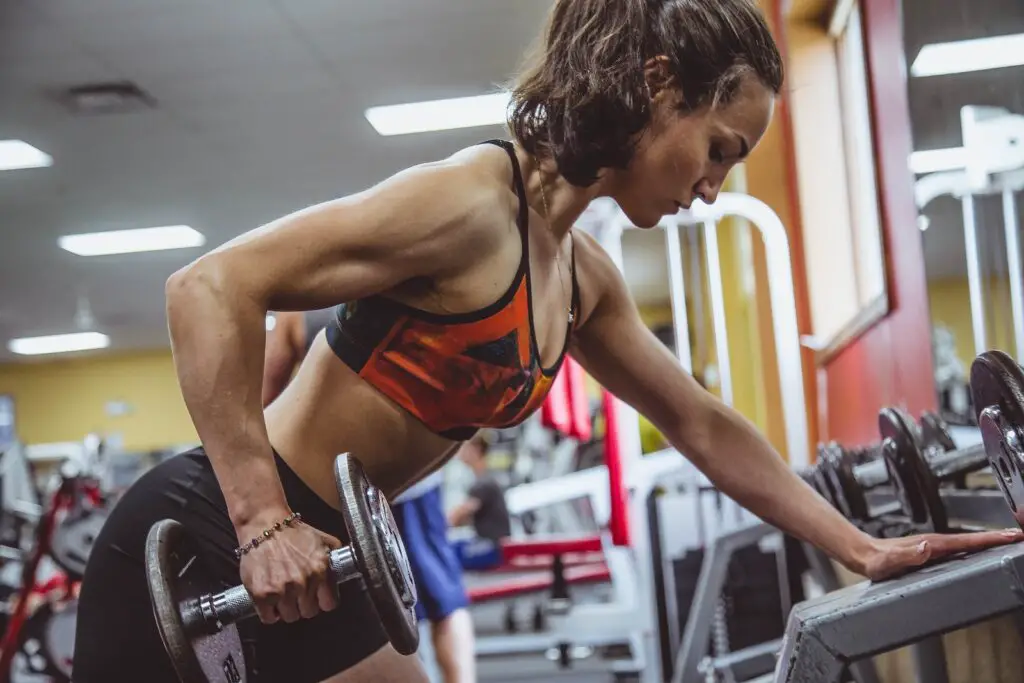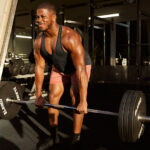Introduction
Shoulder and abs workouts are an essential part of any well-rounded fitness regimen. Strong shoulders contribute to an impressive physique and play a significant role in daily activities. Similarly, a well-defined core comprising the abs is crucial for stability and overall body strength.
Shoulder Workout Exercises

Overhead Shoulder Press:
- Stand with your feet shoulder-width apart and hold a barbell or dumbbell at shoulder height.
- Ensure your core is engaged, and your back is straight.
- Press the weight overhead, extending your arms fully.
- Lower the weight back to shoulder height in a controlled manner.
- Repeat for the desired number of repetitions.
Lateral Raises:
- Stand with a dumbbell in each hand, arms by your sides, and palms facing your body.
- Keep a slight bend in your elbows and raise your arms out to the sides until they reach shoulder level.
- Lower the weights back to your sides.
- Perform this exercise with a slow and controlled motion to avoid swinging.
Front Raises:
- Stand with a dumbbell in each hand, arms by your sides, and palms facing your thighs.
- Keep a slight bend in your elbows and raise your arms forward until they are parallel to the ground.
- Lower the weights back to your thighs.
- Maintain control throughout the movement.
Rear Delt Flyes:
- Bend at the waist with a dumbbell in each hand, palms facing each other.
- Lift your arms out to the sides until they are parallel to the ground.
- Squeeze your shoulder blades together as you lift the weights.
- Lower the weights back to the starting position.
Arnold Press:
- Start with dumbbells at shoulder height, palms facing you.
- Press the weights overhead while simultaneously rotating your palms to face forward.
- Reverse the motion on the way down, rotating your palms back to the starting position.
- This exercise combines front and overhead presses for a comprehensive shoulder workout.
Shrugs:
- Hold a dumbbell in each hand by your sides with your palms facing your body.
- Shrug your shoulders upward as high as possible while keeping your arms straight.
- Squeeze your traps (upper back muscles) at the top of the movement.
- Lower the weights back down, maintaining control.
Upright Rows:
- Hold a barbell or dumbbell in front of your thighs with your palms facing your body.
- Lift the weight toward your chin by bending your elbows and keeping the barbell close to your body.
- Lower the weight back down in a controlled manner.
- Be cautious not to pull the weight too high, which can strain your shoulders.
Face Pulls (for rear deltoids):
- Attach a rope to a cable machine at eye level.
- Hold the rope with both hands and step back.
- Pull the rope towards your face by squeezing your shoulder blades together.
- Your elbows should be high and wide.
- Control the rope back to the starting position.
Push Press:
- Similar to the overhead press but involves a slight dip in your legs for added power.
- Press the weight overhead using the power generated from your leg drive.
- Perform this exercise explosively but with control.
Remember to select a weight that allows you to complete the desired number of repetitions with proper form. If you’re new to these exercises or unsure about your form, consider seeking guidance from a fitness professional or personal trainer. Proper form is crucial to prevent injuries and maximize the effectiveness of your shoulder workout.
Abs Workout Exercises
Certainly, here is a detailed description of various exercises for an effective abs (abdominal) workout:
Crunches:
- Lie on your back with your knees bent and feet flat on the floor.
- Place your hands behind your head or across your chest.
- Contract your abdominal muscles and lift your head, neck, and shoulder blades off the floor.
- Exhale as you come up and inhale as you lower yourself back down.
- Keep your lower back on the floor and avoid pulling on your neck.
Leg Raises:
- Lie on your back with your legs straight.
- Place your hands under your hips or hold onto a bench or sturdy surface for support.
- Keep your legs together and lift them upward, keeping them straight.
- Lower your legs back down without letting them touch the floor.
- Engage your lower abs throughout the movement.
Bicycle Crunches:
- Lie on your back with your hands behind your head and your knees bent.
- Lift your head, neck, and shoulders off the ground.
- Alternate bringing your right elbow toward your left knee while extending your right leg and vice versa.
- Twist your torso as you perform the movement to engage the oblique muscles.
Planks:
-
- Start in a push-up position with your forearms on the ground.
-
- Keep your body in a straight line from head to heels.
-
- Engage your core muscles and hold this position for as long as you can.
- Avoid sagging or lifting your hips; maintain a neutral spine.
Side Planks:
- Lie on your side with your elbow directly under your shoulder and your legs stacked.
- Lift your hips off the ground, keeping your body in a straight line.
- Engage your oblique muscles and hold the position.
- Perform on both sides.
Russian Twists:
-
- Sit on the floor with your knees bent and your feet flat.
-
- Lean back slightly and lift your feet off the ground if you want to make it more challenging.
-
- Hold your hands together or use a weight for added resistance.
- Twist your torso to one side and then the other, touching the ground next to your hip with the weight or your hands.
Hanging Leg Raises
- Hang from a pull-up bar with your arms fully extended.
- Keep your legs straight and raise them as high as you can.
- Lower your legs back down without swinging.
- This exercise targets the lower abs and requires upper body strength.
Reverse Crunches:
-
- Lie on your back with your knees bent and your feet off the ground.
-
- Place your hands by your sides or under your hips for support.
-
- Curl your pelvis off the floor, bringing your knees toward your chest.
-
- Lower your legs back down with control, not letting them touch the floor.
Seated Knee Tucks:
-
- Sit on the edge of a bench or chair with your hands gripping the sides.
- Lift your knees toward your chest, crunching your abs.
- Extend your legs back out in a controlled manner.
For a well-rounded abs workout, include a combination of these exercises in your routine. Remember to focus on proper form, engage your core, and breathe throughout each exercise. It’s also essential to maintain a healthy diet and incorporate cardio and strength training exercises for overall fitness and to reduce body fat, which helps reveal your abdominal muscles.
Tips to Mastering Shoulder and Abs Workouts
-
- Balancing Intensity and Rest: Balancing workout intensity with rest is crucial for muscle recovery and growth. Ensure you allow your shoulders and abs sufficient time to recover between sessions. This will help you build muscle in your upper arms and abs.
-
- Nutrition for Muscle Building: A well-balanced diet with sufficient protein is vital for muscle growth. Consider consulting a nutritionist for personalized guidance. Well-balanced nutrition involves dietary strategies to promote muscle mass growth. It also emphasizes the importance of engaging your core to support your training and fitness.
-
- Staying Consistent with Workouts: Consistency is vital for reaching fitness goals. Regular exercise leads to progression, habit formation, muscle memory, and injury prevention. It also aids in weight management and has mental health benefits. Engaging your core is crucial, and finding an enjoyable and sustainable routine is essential.
-
- Measuring Progress: Monitor your progress by tracking your strength and endurance improvements. Use measurements and photos for visual evidence of your hard work.
Importance of Strong Shoulders and Abs
Strong shoulders provide upper body stability, enhance posture, and reduce the risk of injuries. Whether lifting weights, carrying groceries, or simply reaching for something on a high shelf, your shoulders are at work. A strong core, on the other hand, supports your spine and reduces the risk of lower back pain.
Benefits of Combining Shoulder and Abs Workouts
When you combine shoulder and abs workouts, you create a balanced upper-body workout routine. This synergy enhances overall strength and aesthetics. Plus, it saves time by working two essential muscle groups in one session.
-
- Efficient Time Management: Performing shoulder and abs exercises together can save time, making your workouts more time-efficient.
-
- Core Engagement: Many shoulder exercises engage the core for stability, effectively working your abdominal muscles without needing separate ab exercises.
-
- Improved Posture: Strengthening your shoulders and core can enhance your posture, reducing the risk of slouching and back pain.
-
- Balanced Upper Body Strength: Pairing these workouts helps create a balanced upper body, reducing the risk of muscle imbalances.
-
- Functional Fitness: Developing strong shoulders and abs enhances overall functional fitness, making daily tasks and activities easier.
-
- Enhanced Core Stability: A strong core is essential for stability and injury prevention; combining these workouts can help achieve this.
-
- Calorie Burn: Combining these exercises can lead to a higher calorie burn during your workout due to increased muscle engagement.
-
- Variety: Combining workouts adds variety to your routine, reducing workout monotony and keeping you engaged.

The Synergy between Shoulder and Abs Workouts
The connection between strong shoulders and a solid core lies in their co-dependence. While performing shoulder exercises, a stable body is crucial for proper form and power. Conversely, an intense center provides the foundation for effective shoulder workouts.
Tips for Effective Shoulder and Abs Training
To make the most of your workouts, follow these tips:
-
- Maintain proper form to prevent injuries.
-
- Gradually increase weights and intensity.
-
- Include both compound and isolation exercises.
-
- Ensure a balanced diet with adequate protein intake.

Common Mistakes to Avoid
Common mistakes include:
-
- Using improper form can lead to injuries.
-
- Overtraining, which can hinder progress.
-
- Neglecting rest and recovery.

Sample Shoulder and Abs Workout Routine
-
- Dumbbell Shoulder Press: 3 sets of 10 reps
-
- Lateral Raises: 3 sets of 12 reps
-
- Front Raises: 3 sets of 10 reps
-
- Bent Over Lateral Raises: 3 sets of 12 reps
-
- Crunches: 3 sets of 15 reps
-
- Leg Raises: 3 sets of 12 reps
-
- Planks: 3 sets of 30 seconds
-
- Russian Twists: 3 sets of 15 reps per side
Importance of Warm-Up and Cool Down
-
- Warm-Up: Before any workout, it’s essential to warm up. This phase gradually increases your heart rate and loosens your muscles. It serves as a physical and mental readiness process. A warm-up readies your body for more intense exercise, reducing the risk of injury.
-
- Cool Down: After your workout, a cool down is also essential. It helps your body transition from high-intensity exercise to a state of rest. This gradual reduction of heart rate and circulation is vital. Cooling down helps prevent post-exercise muscle soreness and stiffness while removing waste products from your muscles. It offers mental relaxation and a sense of accomplishment, reducing stress and anxiety.
The Importance of Balanced Workouts

When it comes to working out, balance is critical. Focusing on specific muscle groups, such as the shoulders and abs, is essential. It is also vital to ensure you’re not neglecting other areas of your body.
This article mainly talks about shoulder and ab workouts. But it’s crucial to include exercises that work on other muscle groups to keep your strength and balance in check.
Incorporating Cardiovascular Work
Cardiovascular exercise is essential for maintaining a healthy heart and promoting fat loss. It complements your strength training and can help you achieve a lean and toned physique. Popular cardio exercises include running, cycling, swimming, and HIIT (High-Intensity Interval Training). To maximize the benefits of your workouts, consider adding 2-3 days of cardio into your weekly routine.
Chest and Back Workouts
For a well-rounded upper body workout, it’s crucial to incorporate exercises that target the chest and back. A muscular chest provides upper body strength, and a defined back can improve your posture and overall aesthetics. Include activities like bench presses, push-ups, and pull-ups to work on these muscle groups.
Leg Day: The Foundation of Strength
Don’t skip leg day. Your lower body, including your legs and glutes, is fundamental to your overall strength and athleticism. Neglecting leg workouts can lead to muscle imbalances and hinder your progress in other areas. Squats, lunges, and deadlifts are excellent exercises for building leg strength.
Core Exercises Beyond Abs
While we’ve covered abdominal exercises, expanding your core workout beyond crunches and planks is essential. Strengthening the lower back (lumbar spine) is crucial for overall core stability. Exercises like Superman and hyperextensions can help with this. A strong lower back can prevent injuries and improve your posture.
The Importance of Stretching
In addition to strength training and cardiovascular exercise, flexibility is crucial. Incorporate stretching exercises to improve your range of motion, reduce muscle stiffness, and prevent injuries. Yoga and Pilates are excellent choices for enhancing flexibility and balance.
Nutrition for Muscle Building and Fat Loss
A well-balanced diet is the foundation of any successful fitness journey. For muscle building, ensure you’re consuming enough protein, which is essential for muscle repair and growth. Lean protein sources include chicken, turkey, fish, and plant-based options like tofu and legumes.
Additionally, maintain a caloric intake that aligns with your fitness goals. For fat loss, create a calorie deficit by consuming fewer calories than you burn.
Rest and Recovery
Rest is often an overlooked aspect of a fitness routine. Your muscles need time to repair and grow, so allow a minimum of 48 hours between working the same muscle group. A good night’s sleep is also essential for overall recovery and muscle growth.
Tracking Your Progress
Monitoring your progress motivates and helps you adjust your fitness routine. Keep a workout journal to track your weights and reps in each exercise. Additionally, take photos of yourself to document your journey visually. You can use different smartwatches that can keep progress records automatically.
Consulting a Professional
If you’re new to working out or have specific fitness goals, it’s advisable to consult a fitness professional. A personal trainer can create a customized workout plan. Personal trainers ensure you use the proper form and guide you through exercises that suit your needs.
The Power of Consistency
Consistency is the key to achieving your fitness goals. Sticking to a regular workout routine is vital regardless of whether you work on your shoulders, abs, or other muscle group. Avoid giving in to excuses or skipping workouts.
The Mind-Body Connection
Remember that fitness is not just about the body; it’s also about the mind. Stay positive and motivated. Set achievable goals and celebrate your achievements, no matter how small they may seem.
Conclusion
In conclusion, achieving a strong and toned upper body is attainable through a balanced fitness routine with shoulder and abs workouts. However, working on other muscle groups, maintaining cardiovascular fitness, and focusing on overall health and well-being are equally important. Combining strength training, cardio, and flexibility exercises with a balanced diet and proper rest will help you reach your fitness goals. Stay consistent, and remember that fitness is a journey, not a destination.
Frequently Asked Questions
How do I create a balanced workout routine?
A balanced workout routine includes strength training, cardiovascular exercise, flexibility, and rest. Consult a fitness professional to create a personalized plan.
What is the recommended amount of cardio exercise each week?
As health guidelines recommend, aim for at least 150 minutes of moderate-intensity cardio per week. Or you can try 75 minutes of high-intensity cardio per week.
Is it okay to work out every day?
Working out every day is not suitable for muscle health. Every muscle needs time to recover. Include rest days in your weekly routine.
What is the best time to stretch?
Stretching is beneficial both before and after your workout. Warm up with dynamic stretches before exercise and do static stretches after to improve flexibility.
How long should I stick to a workout routine before expecting results?
Results vary by individual, but you can generally expect noticeable improvements in strength and endurance within 4-6 weeks of consistent training.
[wpcode id=”2855″]




